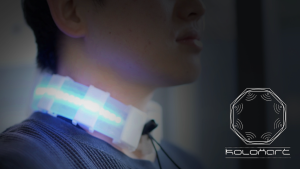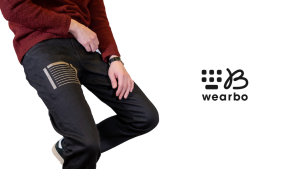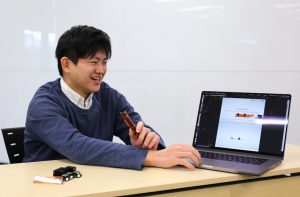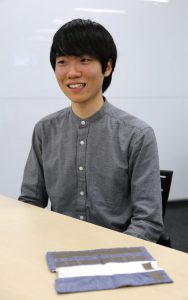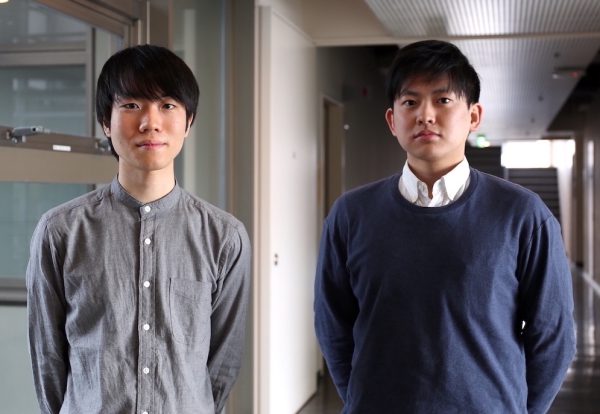
February 17, 2022
飽くなきものづくりへの挑戦:「未踏スーパークリエータ」森田崇文さん・篠田和宏さんインタビューRelentless Passion for Manufacturing: An interview with Takafumi Morita and Kazuhiro Shinoda, Super Creators Certified under the MITOU Program
「突出したIT人材を発掘・育成する」事業として経済産業省が取り組む「未踏事業」の参加者のうち、特に卓越した能力をもった者に与えられる「スーパークリエータ」認定。昨年5月に発表された、2020年度「未踏スーパークリエータ」に認定された方々の中に、森田崇文さん(先端表現情報学コース・博士課程1年)と篠田和宏さん(先端表現情報学コース・修士課程1年)のお名前がありました。
お二人は以前、東大生が独自の技術プロジェクトを行う「本郷テックガレージ」に参加した際にものづくりの楽しさを覚えたことが、未踏プロジェクトに挑戦するきっかけになったと言います。森田さんは仲間とともに「様々な用途にカスタマイズ可能なチョーカー型感覚デバイス」の開発に取り組みました。このチョーカー型のデバイスは、首に装着することで、感覚代行による視覚・聴覚の「補綴」、新たな感覚獲得による人間の可能性の「拡張」を実現するデバイスです。当時は総合分析情報学コースの修士課程でローカル5Gの研究をしていた森田さんは、このプロジェクトを通して、この界隈の魅力に入り込んでいき、博士課程では先端表現情報学コースに進学しました。現在は筧研究室で、液体のふるまいをプログラマブルに制御するフィジカルインターフェースの研究に取り組んでおり、HCI(Human Computer Interaction)分野のトップカンファレンスであるCHI2022に採択され、今年5月に公開予定とのことです。
篠田さんは、未踏プロジェクトでは仲間とともに「布製ウェアラブル手書き入力デバイス」の開発に取り組みました。自分のスマートウォッチでは文字入力がしづらいことに着目し、ズボン型とハンカチ型の入力デバイスを開発しました。最初に開発したズボン型は、なぞって文字を入力するだけのインタフェースで、一見すると服のデザインにも見えます。一方のハンカチ型ではこれをさらに改良し、キーボード入力やゲーム機のコントローラ入力など折りたたんで機能を変更できる、布ならではのインタラクションのできるデバイスを目指しているそうです。学部生のときに取り組んだこの研究がきっかけで、学際情報学府に進学した今は、矢谷研究室にて、さらに様々な入力に対応した、ハンカチ型デバイスの研究を深めていく予定だそうです。
取り組んでいる研究テーマは違いますが、お二人がそれぞれの研究について熱く語ってくださる様子からは、共にものづくりへの情熱と楽しさが感じられました。今後の更なるご活躍を期待しています。
記事:柳志旼(博士課程・編集部)
写真:神谷説子(特任助教・編集部)
(森田さんと篠田さんには、写真撮影時のみマスクを外していただきました)
In May 2021, Takafumi Morita (a first-year doctoral student in the Emerging Design and Informatics Course) and Kazuhiro Shinoda (a first-year master’s student in the Emerging Design and Informatics Course) were among those certified as “MITOU Super Creators” for the academic year of 2020. MITOU Super Creators are chosen among students who have participated in the annual MITOU Program promoted by the Ministry of Economy, Trade and Industry (METI), which aims to discover young individuals with outstanding IT abilities and the potential to create new added value.
During an interview, Morita and Shinoda both said they were inspired to take on the challenge of the MITOU Program after learning the joy of manufacturing from participating in the “Hongo Tech Garage”, where students at the University of Tokyo conduct their own technology projects. Together with his colleagues, Morita worked on the “Customized Choker-type Sensory Device for Various Uses” project. This choker-type device is worn around the neck for “prosthetic” vision and hearing through sensory substitution or for “expanding” human potential by acquiring new senses. At the time, Morita was doing research on local 5G networks in the master’s program of the Applied Computer Science Course. Through this project, however, he became fascinated with this area and moved to the Emerging Design and Informatics Course to pursue his doctorate. Morita, who is now a member of Kakehi Laboratory, is currently working on a physical interface that can programmatically control the behavior of liquids. His work has been accepted for CHI2022, one of the top conferences in the field of HCI (Human Computer Interaction), and is scheduled to be released this May.
For the MITOU project, Shinoda and his colleagues worked on the “Development of a Wearable Fabric Handwriting Input Device” project. Noticing that it was difficult to input text on his smartwatch, he developed pants-type and handkerchief-type input devices. The first one, a pants-type input device, is an interface that allows users to input text by simply tracing letters. At first glance, this device looks like a clothing design. The handkerchief-type input device, on the other hand, is an improved version of the pants-type device. It aims to enable types of interaction that are unique to cloth and can be folded to change its function from keyboard input to game console controller input, for example. Shinoda said this research, which he has conducted since he was an undergraduate student, led him to enter the GSII and the Yatani Laboratory, where he now plans to deepen his research on handkerchief-type devices that support various types of input.
Although they are working on different research topics, Morita and Shinoda’s passion and enjoyment for manufacturing were evident as they talked passionately about their respective research. Best wishes for their continued success in the future.
Text:Jimmine Yoo (Ph.D. Student/Editorial team)
Photos:Setsuko Kamiya (Project assistant professor/Editorial team)
English proofreading:David Buist (Project senior specialist)


